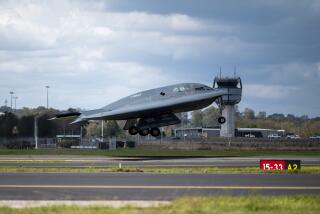Fighter Jets Assume New Protective Role
- Share via
WASHINGTON — The combat air patrols flying over 30 major U.S. cities since Tuesday are the first component of what is expected to be the largest mobilization of the military to protect domestic airspace in U.S. history.
Since about five hours after the attacks, air patrols of F-15 and F-16 fighter jets under the control of the North American Aerospace Defense Command (NORAD) have been flying over Washington, New York, Los Angeles, San Francisco, San Diego and other cities, senior military officials said. President Bush mobilized thousands more Air Force reservists Thursday.
A day earlier, Secretary of Transportation Norman Y. Mineta asked the military to train special forces to serve as marshals on commercial flights. But even as the mobilization gets underway, air defense officials on Friday disclosed that they had scrambled over fighter jets to try to reach two of the hijacked airplanes but were too late to play any role.
After Flight 11 struck the World Trade Center at 8:46 a.m., authorities mobilized two F-15 fighter jets from Otis Air Force Base on Cape Cod, Mass. But the second hijacked plane to strike the World Trade Center hit the tower at 9:02, far too soon for the fighters, which fly at speeds faster than 500 mph, to have gotten close.
The Air National Guard also dispatched two F-16s from Langley Air Force Base in Virginia at 9:35 a.m. to respond to FAA alarms about American Airlines Flight 77, which plunged into the Pentagon.
But the aircraft struck the building two minutes after the fighters took off, he said.
In an interview on the PBS program “The NewsHour With Jim Lehrer,” Deputy Defense Secretary Paul D. Wolfowitz said authorities also were tracking the plane that crashed in Pennsylvania.
“I think it was the heroism of the passengers on board that brought it down, but the Air Force was in a position to do so if we had to,” Wolfowitz said.
Maj. Gen. Paul A. Weaver Jr., director of the Air National Guard, said that only the president could give the order for a U.S. fighter to shoot down a commercial airliner filled with American travelers.
The air defense mobilization efforts, meanwhile, reveal gaping holes in the nation’s system for protecting its skies.
The military has never played a role in monitoring the movements of airplanes over the nation, unless they originate from abroad. And while at the height of the Cold War thousands of Air Force fighter jets stood on active alert around the country to intercept hostile aircraft, the Air Force today is practically out of the interception business altogether.
Today, only 60 aircraft manned by active duty crews are on alert to intercept suspicious craft.
And while NORAD has, since its founding in 1958, been responsible for preventing foreign aircraft from invading U.S. airspace, it does not monitor domestic flights at all.
“The explanation for not having a quick response is very simple,” said one Air Force general who has been fuming for months about Pentagon plans to further reduce the size of the air defense force. “We just didn’t take any of these threats seriously.”
No longer. Secretary of Defense Donald H. Rumsfeld said combat planes are flying over the New York-Washington corridor to protect flights. Navy ships have been assigned to NORAD to patrol territorial waters and help monitor the airspace. Canadian CF-18 fighter jets are also helping to patrol the skies under a binational agreement with the U.S.
While standard rules of engagement require the U.S. and Canadian fighter pilots to first interrogate a suspicious aircraft and allow the crew to explain its intentions, NORAD spokeswoman Capt. Adriane Craig said that “shooting down an aircraft is absolutely not out of the question.”
The nation’s system for monitoring the skies was developed during the Cold War and has been dictated by Cold War thinking ever since.
During World War II and in the years immediately afterward, an Air Force program called the Air Defense Command had thousands of fighter jets on alert throughout the U.S. in case of a bomber attack. But in 1957, when the Soviets sent up the Sputnik satellite, the nature of the threat to the U.S. appeared to change.
The concern that the Soviets would send bombers over the United States was supplanted by the fear that the enemy would launch intercontinental ballistic missiles. Because of that, NORAD was born.
Encased a third of a mile within a Colorado mountain, under a million tons of dense granite designed to resist a nuclear attack, soldiers assigned to NORAD still monitor giant radar images, waiting for the telltale blip of an incoming airstrike.
As money poured in over the decades to strengthen NORAD, it poured out of old-fashioned air defense programs.
Pentagon planners had been debating until Tuesday’s attack whether to recommend that the number of fighter jets on ready alert in the U.S. be reduced even further in coming years. While defense officials say a decision had not yet been made, the idea of a reduction in air defenses had been gaining currency in recent months among task forces assigned by Rumsfeld to put together recommendations for a reassessment of the military.
But even critics of such drawdowns said the military would have been hard-pressed to foresee an attack such as the one that took down the World Trade Center and part of the Pentagon.
“It would have been too incredible to imagine,” Thompson said.
More to Read
Sign up for Essential California
The most important California stories and recommendations in your inbox every morning.
You may occasionally receive promotional content from the Los Angeles Times.











